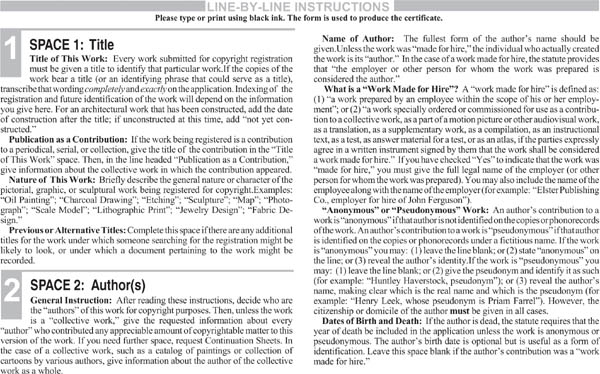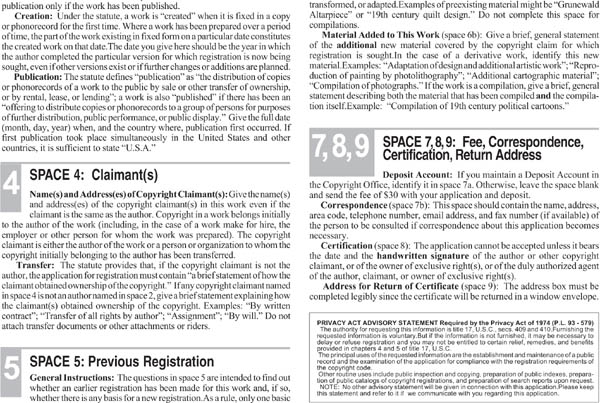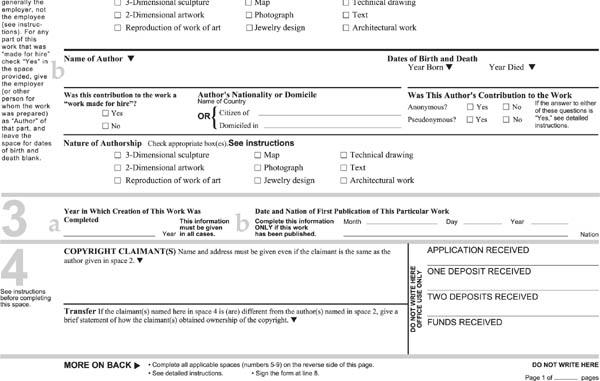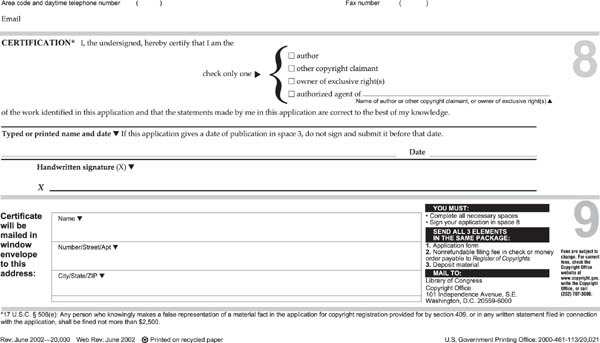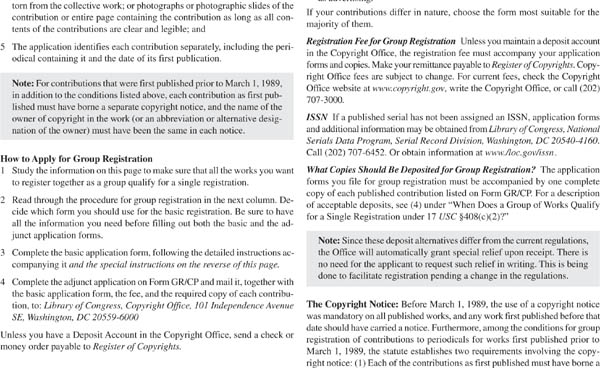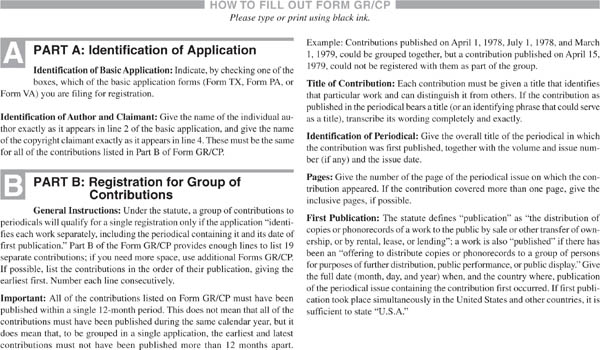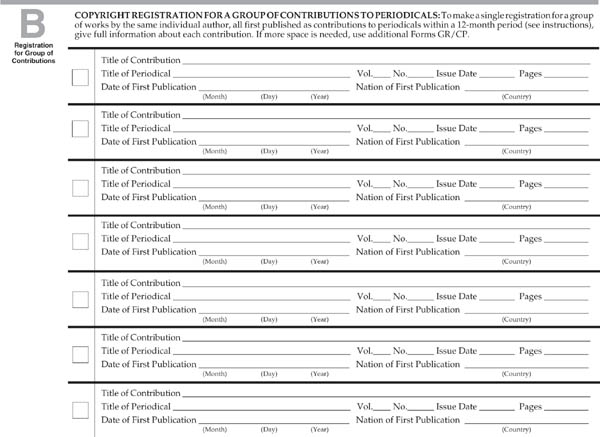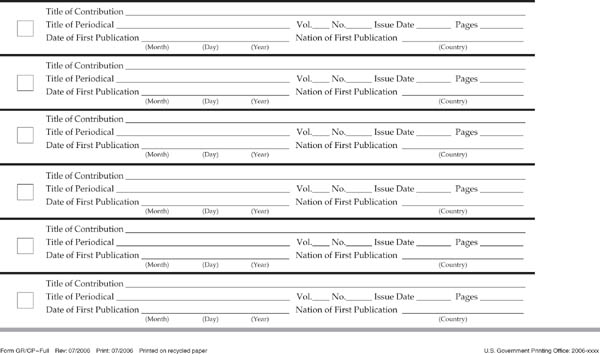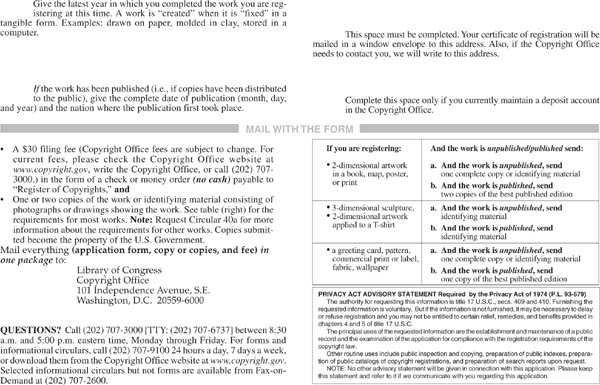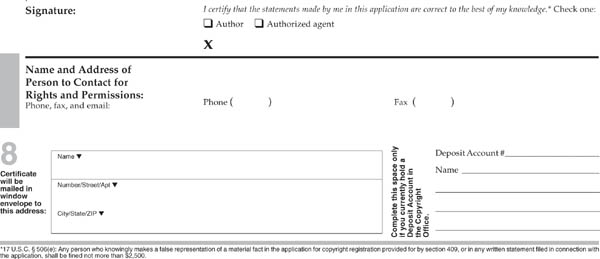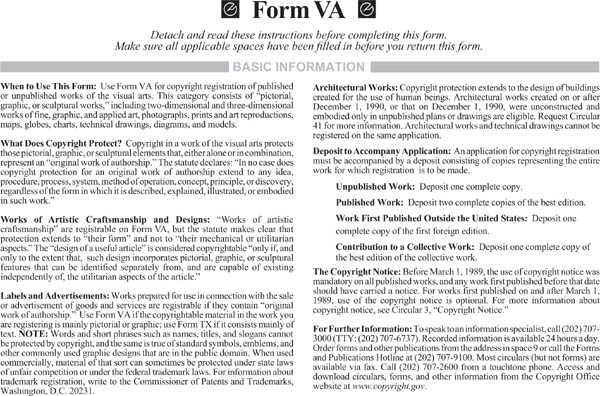
3 COPYRIGHT: REGISTRATION
All works subject to copyright protection may be registered with the Copyright Office, whether or not they have been published. Before 1978 some people would place manuscripts or copies of artwork in a self-addressed envelope and send the envelope to themselves by registered mail. This was called “poor man’s copyright” and was, frankly, of little value even before 1978. Today, it should never be done. The Copyright Office is an official repository for copyright applications. All works, whether published or unpublished, can be registered. The cost of registration is not great, and groups of works can be registered for one fee in many cases. The registration process has become one predominantly performed through the Internet, and the office actively discourages the use of traditional paper forms. The fees, and the office’s marked preference for online registration, will be discussed further in this chapter. That being said, certain kinds of registration, including group registration, and copyright renewals, require submission of paper forms. Regardless of how a work is registered, however, there are substantial benefits to registering a work with the Copyright Office. In addition, even if a work is denied registration, a copy of the deposit is maintained by the Copyright Office.
Choosing the Copyright Form
The Copyright Office’s preferred approach to registration is through the electronic copyright office, or eCO. The eCO system is the ways in which works can be registered over the Internet. It can be used to register single or, in certain cases, multiple works claimed by the same artist, author, or rights holder. The procedure permits online payment of the $35 application fee via credit card or direct transfer from a checking account, after which the artist can upload a digital version of the work to the Copyright Office. The speed of the Internet connection determines how much an applicant may upload, as the eCO system gives all users up to sixty minutes before terminating an upload. The system permits registrants to pay for and track their applications online, and submit the works over the Internet. In the event the artist wants also to submit a hard copy, he or she can print out a shipping label for each registered work using the eCO system, and mail the work to the office using those labels.
In addition to eCO, the Copyright Office also offers registrants Form CO, a unified form that supplants prior specialized forms, such as the Form VA. Though the earlier forms are available by mail request, only the Form CO is published on the copyright register’s Web site. Form CO is designed to be filled out electronically, printed, and then mailed back to the Copyright Office along with a copy of the work to be registered. The filing fee for the paper form was recently raised to $50, again signaling the Copyright Office’s increasing hostility to paper submissions.
The predecessors to eCO and Form CO are specialized forms for registering visual or written works (VA and TX, respectively), and are available by mail request to the Copyright Office. On the Copyright Office Web site, they are also available as part of the downloadable GR/CP forms described later in this chapter. A copy of Form VA is also printed on pages 26–29. In keeping with the Copyright Office’s preference for electronic filings, however, the fees for submitting paper forms ($65) are almost twice as high as the eCO. The process also takes longer, since all communication is carried out over U.S. Post and the information in the paper form must be digitized by the Copyright Office.
When registering something with visual and written components, Form CO allows an artist to classify the work as either a literary work or a visual arts work. In the prior forms regime, the predominance of textual or visual elements would govern which registration form was required. However, such classifications are for administrative purposes only, and protection will not be diminished simply because the artist makes a mistake in choosing the correct classification. Also, when registering a contribution to a magazine or other collective work, the class to be used is that for the contribution and not the class into which the entire collective work falls.
A copy of Form VA appears on pages 26–29. This is a simple two-page form with step-by-step directions explaining how to fill it out. Along with the appropriate form, the filing fee of $65 and copies of the work being registered must be sent to the Copyright Office. The application form, copies of the work, and fee should be mailed in one package, unless the artist doesn’t have to include the fee because he or she maintains a deposit account with the Copyright Office.
Advantages of Registration
Registration is not necessary to gain copyright protection—protection exists the moment a work is created under the 1978 law. But registration does have the following important advantages: (1) the certificate of registration, if issued either before or within five years of first publication, is presumptive proof of the validity of the copyright and the truth of the statements made in the copyright application; (2) registration must be made before an infringement commences in order to qualify to receive attorney’s fees and “statutory” damages (a special kind of damages that an artist can elect to receive if actual damages are hard to prove), except that a published work registered within three months of publication would still qualify; (3) registration is necessary in order to bring a suit for infringement of copyright (unless the infringed work is protected under the Berne Convention and its country of origin is not the United States); and (4) with respect to works published from January 1, 1978, to March 1, 1989, registration cuts off certain defenses that an innocent infringer might be able to assert due to a defective copyright notice.
Congress attempted, at one point, to eliminate the need for registration as prerequisite to bringing infringement litigation or obtaining statutory damages and attorney fee awards. The effort received strong support from the Graphic Artists Guild and the American Society of Media Photographers, but was opposed by the Authors Guild. Its ultimate defeat left Section 412, “Registration as a prerequisite to certain remedies for infringement,” as the only governing law.
As mentioned, works originating in a Berne Union country other than the United States do not have to be registered prior to commencing a lawsuit for infringement. Because of the other advantages of registering, the copyright owners of such foreign works will presumably be inclined toward registration.
Registration requires submission of an acceptable application, deposit of the work to be protected, and a fee. The date on which the Copyright Office receives all three elements generally determines the effective date of registation.
To correct a mistake or amplify information contained in a completed registration, Form CA for supplementary registration is used. Form CA may be submitted only after a registration number has been obtained for the work. It should not be used to renew copyright, or to update copyright on a work that has substantially changed since it was first registered. In the latter case, the artist should submit a new registration form for the changed work.
Circular 40, “Copyright Registration for Works of the Visual Arts,” offers information as to registering single or multiple works. Circular 44, “Cartoons and Comic Strips,” discusses both registration and deposit for cartoons and comic strips. Circular 55 discusses registration of “multimedia works” combining two or more forms of expression, while Circular 66 details registration of “online works,” which includes Web sites and other works made available over a communications network. Fact Sheet FL 107, “Copyright Registration of Photographs,” describes the process for registering unpublished or published photos. Fact Sheet FL 124, “Group Registration of Published Photographs,” discusses how up to 750 published photographs may be registered under a single application and fee. Though FL 124 generally discusses group registration of published photographs, the reference to group registrations exceeding 750 images deals only with unpublished images. As discussed below, this kind of registration can be done using Form CO and a number of Form CON continuation sheets, or through the eCO.
Group Registration Using eCO or CO
Neither eCO nor Form CO is designed for group registration, though certain kinds of group registration are possible using these approaches. For example, a collection of unpublished works by the same author or claimant can be registered using Form CO or eCO. Similarly, a collection of published works contained in a single publication (i.e. a photo-book or calendar containing multiple images) can be registered using eCO or Form CO.
What if work has been published in a number of magazines? Though the eCO does not address this situation, the law specifically provides for group registration of contributions to periodicals and newspapers made by an artist during a twelve-month period, as long as each contribution has the same copyright claimant (and, if published before March 1, 1989, also had copyright notice in the name of the copyright claimant). In such a case, Form GR/CP is used as an addition to the basic application on Form VA or Form CO; both VA and GR/CP are available for download as a single package on the “Forms” section of the Copyright Office Web site. A copy of Form GR/CP also appears on pages 30–35.
Thus published contributions to magazines and, as discussed in the next section, unpublished photographs can be registered as groups either over the Internet or using paper applications.
Group Registration Not Using eCO and CO
For other types of group registration, however, an applicant must resort to the use of the more traditional paper forms.
A group registration of unpublished works can be made under a single title and registration fee. Registering an unpublished collection can sharply reduce the cost of registering each work in the collection (and no copyright notice need be placed on unpublished work). To qualify for such a group deposit, the following conditions have to be met: (1) the deposit materials are assembled in an orderly form; (2) the collection bears a single title identifying the work as a whole, such as “Collected Drawings of Jane Artist, January 2012”; (3) the person claiming copyright in each work forming part of the collection is also the person claiming copyright in the entire collection; and (4) all the works in the collection are by the same person or, if by different persons, at least one of them has contributed copyrightable material to each work in the collection.
There is no limit on the number of works that can be included in a collection. Also, the law specifically states that a work registered when unpublished need not be registered again when published. Of course, if new material is added to the work or it is transposed into a new medium, creating a substantial variation from the registered work, it would be desirable to register the work again to protect the changed version. In the event of litigation, it is important that the work deposited with the Copyright Office show all of the aspects protected by the copyright being contested in the lawsuit. Also, for any deposit with the Copyright Office, the deposit materials should not be likely to fade or alter with time.
A separate procedure exists for registering groups of published photographs. Up to 750 photographs, taken by a single photographer and published within a 12-month period, may be registered under a single fee using Forms VA and Gr/PPh/CON. The process requires the registrant to submit a Form VA, and attach to it a number of continuation sheets (Gr/PPh/CON) stating the name and publication date of the photographs in the group. Because eCO does not support the uploading of so many images in a single application, the deposit for a Gr/PPh/CON continuation form must be mailed, either in the form of prints, slides, contact sheets, videos, photocopies of the published form, or on CD/DVD-ROM. If the photos were published at different times, the applicant must indicate the name or number of each photograph, and its date of publication, using “continuation sheets.” Each Gr/PPh/CON continuation sheet accommodates up to fifteen photos, and an applicant may submit a maximum of fifty such sheets with a single Form VA.
The Copyright Office also permits applicants to register more than 750 unpublished photographs in a single application. This can be done using either Form VA and accompanying Form CON continuation sheets, Form CO, or the newer eCO procedure.
The artist will want to register contributions, even if the periodical or newspaper is also registered by the owner of its copyright. The registration of the collective work by its owner may not confer the benefits of registration on the artist, since the artist’s copyright in the contribution is separate from the copyright in the collective work (but see, for a case in which a magazine’s registration did effectively register a contribution, Curtis v. General Dynamics Corp., 1991 Copyright Law Decisions, Paragraph 26,776). Also, if the artist is going to use Form GR/CP with Form VA, it would be wise to file every three months in order to be certain of qualifying for attorney’s fees and statutory damages in the event of an infringement, as explained in the section on registration.
Deposit
With the registration form and fee, one complete copy of an unpublished work or two copies of a published work should be sent to the Copyright Office. If editions of differing quality have been published, the Copyright Office regulations provide guidelines to determine which edition is to be considered the best. These guidelines are examined in Circular 7b, ‘“Best Edition’ of Published Copyrighted Works for the Collections of the Library of Congress.” For works first published outside of the United States, only one complete copy of the work need be deposited. If a work is published simultaneously in the United States and abroad, it is treated as if first published in the United States. A helpful publication from the Copyright Office is Circular 40a, “Deposit Requirements for Registration of Claims to Copyright in Visual Arts Material.”
For registrations under the provision allowing group registrations for contributions to periodicals and newspapers, the deposit materials can be one copy of any of the following: (1) one complete copy of each periodical or section of a newspaper in which the work appeared; (2) the entire page containing the contribution; (3) the contribution clipped from the collective work; or (4) one photocopy of the contribution.
When registering published greeting cards, picture postcards, or stationery, only one complete copy need be deposited. Similarly, only one complete copy has to be deposited for commercial prints, labels, advertising catalogs, and other advertising matter used in connection with the rental, lease, lending, licensing, or sale of articles of merchandise, works of authorship, or services. This would include, for example, the advertising used in connection with a motion picture. If the print, label, advertising catalogs or other advertising material appears in a larger work, the page or pages on which it appears can be submitted in place of the larger work. If it appears on a three-dimensional work, an alternate deposit must be made as explained in the next section.
Only one complete copy of the best edition of a published work must be deposited for two-dimensional games, decals, fabric patches or emblems, calendars, instructions for needle work, needle work, and craft kits. Likewise, only one copy need be deposited for a box, case, carton, or other three-dimensional container.
For a published motion picture, whether on film or videotape, only one complete copy need be deposited. For an unpublished motion picture, one complete copy must be deposited or, instead, the alternate deposit materials described in the next section may be submitted. It is possible, when submitting a copy of a published motion picture, to enter into a “Motion Picture Agreement” with the Librarian of Congress. This Agreement provides for the copy to be immediately returned to the artist subject to recall by the Library of Congress. There is no requirement to deposit photographs with either a published or an unpublished motion picture, but in either case the deposit must include a separate description with respect to the content of the work, such as a continuity, press book, or synopsis.
For a multimedia kit first published in the United States, the required deposit is one complete copy of the best edition. Circular 55, “Copyright Registration for Multimedia Works,” discusses the variety of deposit requirements, as well as the appropriate application forms, for the different combinations of works that may compose a multimedia kit.
The deposit for works fixed in CD-ROM format is one complete copy, which includes a copy of the disk, a copy of any accompanying operating software and instructional manual, and, if the work is in print as well as on the disk, a printed version of the work. All of these components should be provided, whether or not individually copyrightable.
Alternate Deposit
In certain situations it is possible to make an alternate deposit in place of the actual work itself. This may allow saving a great deal of expense by depositing something in place of copies of a work. Regardless of whether a work is published or unpublished, generally only one set of alternate deposit materials need be sent in. Combining this with the group deposit provisions, all the benefits of registration may be gained without great cost.
Alternate deposit can be made for an unpublished motion picture or, in some cases, for a published or unpublished soundtrack that is an integral part of a motion picture. It can be made for pictorial or graphic works if: (1) the work is unpublished; (2) less than five copies of the work have been published; or (3) the work has been published and sold or offered for sale in a limited edition consisting of no more than three hundred numbered copies. If the work is too valuable to deposit, a special request may be made to the Copyright Office for permission to submit identifying material rather than copies of the actual work.
Alternate deposit materials must be sent in for three-dimensional works and oversize works (which are those exceeding ninety-six inches in any dimension). If this mandatory requirement of alternate deposit would create a hardship due to expense or difficulty, a special request may be made to the Copyright Office to deposit actual copies of a work.
The regulations allow the deposit of an actual copy of small pieces of published jewelry made of inexpensive metal and of published games consisting of multiple parts in boxes or containers no greater than twelve-by-twenty-four-by-six inches.
The alternate deposit for an unpublished motion picture can be either: (1) an audio cassette or other reproduction of the entire soundtrack of the motion picture and a description of the motion picture; or (2) a set consisting of one frame enlargement or similar visual reproduction from each ten minute segment of the motion picture and a description of the motion picture. The description can be a continuity, a pressbook, or a synopsis, but it must in all cases include: (1) the title or continuing title of the work and the episode title, if any; (2) the nature and general content of the program; (3) the date the work was created and whether or not it was simultaneously transmitted; (4) the date of the first transmission, if any; (5) the running time; and (6) the credits appearing on the work, if any. A motion picture’s soundtrack can be registered separately if it has not been embodied in any form other than as a soundtrack that is integral to a motion picture. The alternate deposit for a soundtrack consists of a transcription of the entire work, or a reproduction of the entire work on a tape or record, accompanied by photographs or other reproductions from the motion picture showing the title of the picture, the soundtrack credits, and the copyright notice for the soundtrack, if any. For both motion pictures and separate motion picture soundtracks, the reproductions for deposit can be photographic prints, transparencies, photostats, drawings, or similar two-dimensional renderings that are visible without use of a machine.
A different set of rules for alternate deposit apply for works that are pictorial or graphic, three-dimensional, or oversize. The materials used for alternate deposit can be photographic prints, transparencies, photostats, drawings, or similar two-dimensional reproductions or renderings of the work in a form that can be looked at without the aid of a machine. The materials used for alternate deposit should all be of the same size, with photographic transparencies at least 35mm (mounted if three-by-three inches or less, and preferably mounted even if greater than three-by-three inches) and all other materials preferably eight-by-ten inches (but no less than three-by-three inches and no more than nine-by-twelve inches).
For pictorial and graphic work, the materials must reproduce the actual colors of the work. In all other cases, the materials may be either in color or in black and white. Also, except for transparencies, the image of the work must be life size or larger or, if it is less than life size, it must be large enough to show clearly the entire copyrightable content of the work. The title and an exact measurement of one or more dimensions of the work must appear on the front, back, or mount of at least one piece of the identifying material, and the position and form of the copyright notice must be shown clearly on at least one piece of the identifying material if the work has been published. The piece showing the copyright notice does not have to be of uniform size with the material showing the work itself. For example, a 35mm transparency of the work could be accompanied by a drawing of up to nine-by twelve-inches showing the exact appearance and contents of the notice, its dimensions, and its position on the work.
Deposit for the Library of Congress
In addition to depositing copies for copyright registration, copies may also have to be deposited for the Library of Congress when work is published in the United States on or after March 1, 1989 (or if the work was published with a copyright notice in the United States from January 1, 1978, to March 1, 1989). For published work, the requirement of deposit for the Library of Congress can be satisfied by simply making the correct deposit for registration and sending in the application form and fee with the deposit within three months of publication. For work that has previously been registered as unpublished, within three months of publication two copies of the best edition of the work should be deposited for the Library of Congress.
However, many works will be exempt from deposit, including three-dimensional sculptural works; contributions to collective works; greeting cards, picture postcards, and stationery; prints, labels, advertising catalogs, and other advertising matter published in connection with renting, leasing, lending, licensing, or selling merchandise, works of authorship, or services; and any works published only on jewelry, dolls, toys, plaques, floor coverings, wallpaper, textiles and other fabrics, packaging, or other useful articles.
In addition, for published pictorial and graphic works, it is possible to deposit one complete copy or make an alternate deposit of identifying materials if either: (1) fewer than five copies of the work have been published, or (2) the work is published and offered for sale in a limited edition of three hundred or fewer numbered copies. This is of particular help to printmakers, who had to deposit two copies of fine prints prior to 1978.
The requirement of deposit for the Library of Congress does not in any way affect the copyright protection already in effect. If, for example, an artist registered a work when unpublished and didn’t bother to send in the required copies upon publication, the Register of Copyrights could request copies from the artist. Only if the artist didn’t comply with such a request within three months would he or she become liable for fines and other penalties. However, the copyright would remain valid.
The Process of Electronically Registering a Copyright
The simplest and least expensive method for registration of copyright is through the eCO (Electronic Copyright Office). This icon, which is prominently located on the Copyright Office’s main page, directs applicants to a collection of rules and guidelines for using the system. The eCO is usable by any applicant registering (1) a collection of works first published in the same unit of publication; (2) a collection of unpublished works; (3) collective works; and (4) single works, even if those works contain multiple authorship elements by different authors. The key underlying requirement is that a single claimant be making the registration, and that the claimant have copyrightable contributions in all of the works he or she seeks to register.
The system requires applicants to create a user profile that they may revisit in the future. In it, the Copyright Office will ask for an applicant’s name, an e-mail address, phone number, and postal address. Applicants will also create a username and password identifying their account, and thereby permitting them to file multiple applications, and track the status of pending or completed registrations. The $35 fee for using the service is payable by credit or debit card. Alternatively, applicants can open an account with the Copyright Office using the Pay.gov system, and deduct the cost of multiple applications from such accounts.
Once payment is made, applicants may upload their deposit in electronic form. The various electronic formats that the Copyright Office supports are described at www.copyright.gov/eco/help-file-types.html. If the applicant’s upload is not among the file types described in the eCO guidelines, he or she must convert it before uploading.
Though there is no set size limit on files, there is a time limit for file uploads. Applicants have up to an hour before the Copyright Office server times out; hence, an applicant with a fast broadband Internet connection can upload much larger files than an applicant using a dialup service. In the event that the work requires physical deposit, the “best edition” guidelines are discussed in Circular 7b. The eCO system permits applicants to print special shipping labels, hence assuring that the mailed materials are not mismatched or assigned to a different application.
Filling out Copyright Forms
Most applicants who cannot or choose not to use eCO will use the Form CO to register their copyright. This form is designed to be filled out using a computer, printed, and mailed back with the appropriate fee and deposit. The form itself is self-explanatory; the process of filling it out is described in a separate, downloadable instruction sheet, and is also described below in abbreviated form.
First, check the box that best describes the type of work being submitted for registration. If the work contains more than one type of authorship, choose the type that predominates in the work.
Next, provide a single title, as it appears on the copy, in the appropriate space. If there is no title on the copy, give an identifying phrase to serve as the title or state “untitled.” Use standard title capitalization without quotation marks; for example, The Old Man and the Sea. Up to fifty additional titles can be registered by clicking the “additional title” button as many times as necessary. To register more than fifty titles, file electronically or request the appropriate paper application with continuation sheets by mail (Form CON). In the “previous or alternative title” section, provide any additional titles the work may be known by.
Next, enter the year in which the submitted work was completed. Do not submit the completion dates of newer or older versions of the same work. If the work has been published, the year of completion cannot be later than the year of first publication.
If the work was published, enter the complete date, (mm/dd/yyyy) on which the work was first published. Do not enter future publication dates. Next, enter the nation where the work was first published. Enter “United States” if the work was published in the United States at the same time or before it was published abroad.
If this work has been published as part of a larger work, enter the title of that larger work in the field “Published as a contribution in a larger work entitled.” If the larger work includes a volume, number, and/or issue date, add that information in the lines provided.
In Section 2, complete the “Personal name” entry by entering the author’s name into 2a. If the work was “made for hire,” enter the fullest form of the corporation or organization that commissioned the work into 2b. Under no circumstance should 2a and 2b be completed, as they are mutually exclusive fields. In general, the individual who actually created the work is the author; in the case of a “work made for hire,” however, the hiring party owns the copyright. See chapter 4 for a detailed discussion of “work for hire.” Also, in section 2c, the registrant may give the name under which the author does business by prefacing the name with phrases like “doing business as,” “trading as,” “sole owner of,” or “also known as.” Additional authors may be added by clicking the “additional authors” button.
In field 2d, provide the author’s year of birth. Though this is an optional field, it is very useful as a form of author identification, since many authors share the same name. 2e calls for the author’s year of death; this information is required if the author is deceased, since it is crucial for determining the length of the copyright term. In 2f, check to indicate whether the author is a U.S. citizen. If not, enter the author’s country of citizenship. Alternatively, the registrant may name the nation where the author permanently resides.
Complete 2g only if the work is “made for hire,” if the author is anonymous, or if the author uses pseudonyms or fictitious names. Details on the “work for hire” doctrine can be found in chapter 4 of this book, and in Circular 9, which can be downloaded from the Copyright Register’s Web site. If the author is anonymous, make sure that the author’s legal name is listed in 2a, or that the word “anonymous” appears in field 2a. If the author uses pseudonyms, provide them in the appropriate box in 2g, and in 2a.
In field 2h, check the box that describes the kind of authorship the author contributed to the work being submitted. There are a number of options in selectable checkboxes, and an “other” box that allows registrants to describe forms of authorship not covered by the default options. Examples of such contributions might include choreography, musical arrangement, translation, dramatization, or fictionalization. Contributions listed in 2h cannot pertain to conceptualization, procedure, development of ideas, or invention; copyright is designed to protect the fixed and tangible expression of an idea or concept, rather than the idea or concept itself.
Section 3 collects the copyright claimant’s information. While one normally thinks of the author or artist as the owner of a copyright in a work, quite often the copyright in a work of visual art is owned by someone other than the artist. For example, if a work was “made for hire,” the hiring party owns the copyright. Further, artists can transfer copyright in their work to others, who would then seek to register their rights.
Fields 3a and 3b are mutually exclusive; an individual registrant should enter a personal name in 3a, while an organizational registrant should enter the full name of the organization. As in 2a and 2b, registrants can submit alternate “doing business as” names, provided they preface the name with the appropriate prefix, such as “also known as,” “trading as,” and so on. 3c requires registrants to submit their postal and e-mail addresses, and phone numbers.
3e applies to any registrant who did not author the work being submitted for registration. If the registrant is not the artist, he or she must indicate how he or she acquired ownership by checking the appropriate box.
Section 4 applies to artists whose work is based on materials that were previously published, copyrighted by another, in the public domain, or otherwise not owned by the claimant. The purpose of the section is to limit the scope of copyright protection, so that only the new subject matter in the submitted works is registered. 4a allows the registrant to identify text, artwork, drawings, photographs, or video that were not created or owned by the author or registrant. 4b asks the registrant to identify prior versions of the work that have already been registered, or to identify multiple registrations. 4c requires the registrant to specifically identify what aspects of the submitted works are new, and therefore deserving of copyright protection.
Section 5 identifies to the public who should be contacted in the event someone wants to secure a right or license to the copyrighted work. The artist or registrant can enter his or her own contact information here, but doing so makes the contact information available to the public. He or she may also use Section 5 to designate another party to receive inquiries as to rights and licensing in the registered work.
The information provided in Section 6 apprises the Copyright Office of who to contact if there are questions or concerns surrounding the registration of the submitted materials. Section 7 allows the registrant to designate an address to which the registration certificate will be mailed. Finally, Section 8 requires the registrant to sign, date, and certify the application to register the submitted work.
Using Paper Forms
While eCO, or alternatively Form CO, are the preferred registrations forms for most work, as described earlier in the chapter there are certain materials that must be registered using paper forms. For those situations, or if the artist simply prefers to use the paper forms and pay more, the following discussion reviews a number of alternatives. Note that although Form VA is not ordinarily available through the Copyright Office Web site (and must be requested in paper form from the Copyright Office), the GR/CP form download includes a copy of Form VA in electronic form that can be filled in and printed out.
The assumption is that an individual artist, working under his or her own name, created a work and now wants to register it. If these assumptions are correct and, in addition, the work is completely new (does not contain previously published or public domain work), then Short Form VA could be used instead of Form VA. Filling out Short Form VA would be like filling out Form VA but even simpler.
1. Unpublished pictorial, graphic, or sculptural works. Use Form VA. Space 1—Fill in the title of the work and the nature of the work, such as its being an oil painting or a charcoal drawing. Space 2—Give the artist’s name and indicate that the work is not a work for hire. Give the date of the artist’s birth, indicate the appropriate country of his or her citizenship or permanent residence, and indicate that the work is neither anonymous nor written under a pseudonym. Where it says “Author of,” check the appropriate box. Space 3—For an unpublished work give the year the work was finished; leave blank the date and nation of first publication. Space 4—The artist’s name and address should be shown for the copyright claimant. Space 5—Answer no, as the artist will not have previously registered the work. A yes answer would be appropriate if the artist were adding new material to work that had been previously registered, in which case the appropriate box should be checked. Space 6—If the artist has added new material to a previously registered work, explain what material the artist added to the old work to make a derivative work. The artist’s registration would then protect the new elements of the derivative work. Space 7—Fill in the information about a deposit account if the artist has one. Also, give the artist’s name and address for correspondence purposes. Space 8—Check the box for author, sign your name and then print or type his or her name. Space 9—Enter the artist’s name and address so that the certificate of registration will be mailed to the artist.
2. Group registration for unpublished pictorial, graphic, or sculptural works. Use Form VA, filling it out exactly as for an unpublished pictorial, graphic, or sculptural work, except for the changes shown here. Space 1—The collection must have its own title, and it is that title that is used here. Space 3—The year in which creation of the work was completed is the year in which the most recently completed work contained in the collection was completed.
3. Published pictorial, graphic, or sculptural works. Use Form VA, filling it out exactly as for an unpublished pictorial, graphic, or sculptural work, except for the changes shown here. Space 3—In addition to giving the date of creation, give the date and nation of first publication of the work.
4. Group registration of published contributions to periodicals. Use Form VA if the contributions are pictorial or graphic, along with the adjunct Form GR/CP. To qualify, the contributions must meet the criteria listed on page 30. Form VA is filled out exactly as for a published pictorial or graphic work, except for the changes shown here. Space 1—In the space for the title, write “See Form GR/CP, attached” and leave the other parts of Space 1 blank. Space 3—Give the year of creation of the last work completed and leave blank the date and nation of first publication.
Then fill out Form GR/CP. Space A— Mark Form VA as the basic application and give the artist’s name as both author and copyright claimant. Space B—For each box, fill in the requested information about the title of the contribution, the title of and other information about the periodical, and the date and nation of first publication. Mail Form GR/CP with Form VA, the deposit copies, and the filing fee.
5. Unpublished audiovisual works, including motion pictures. Use Form PA. This is filled out in essentially the same way as for an unpublished pictorial, graphic, or sculptural work.
6. Published audiovisual works, including motion pictures. Use Form PA. This is filled out essentially the same way as for a published pictorial, graphic, or sculptural work.
